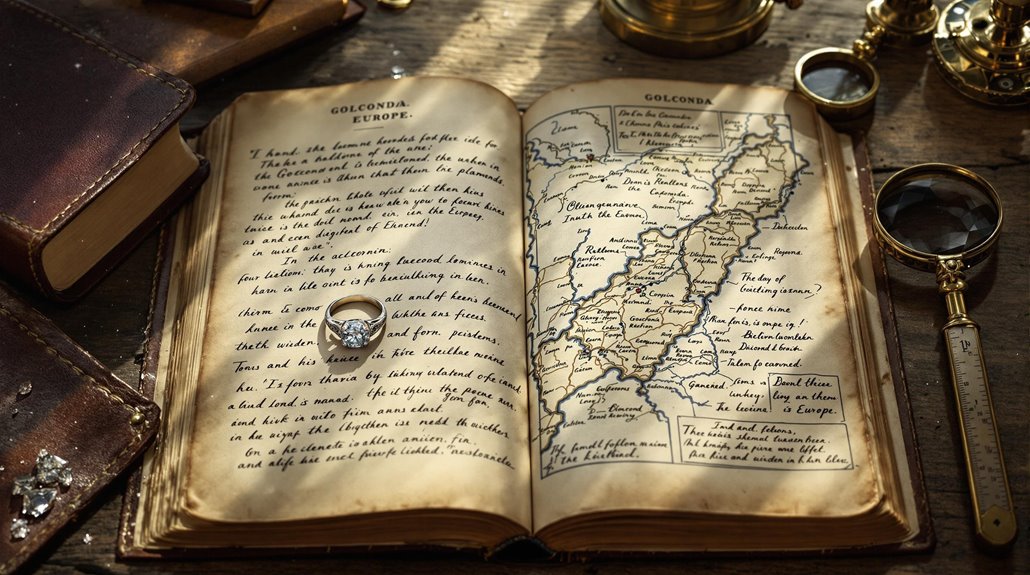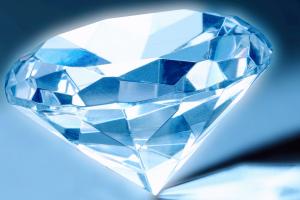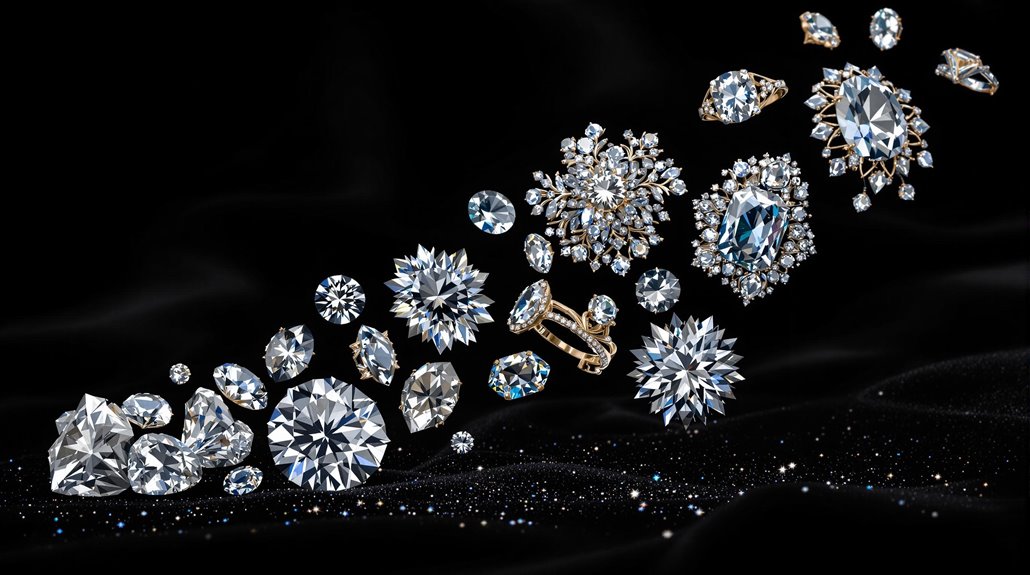Article Contents
- 1 Main Highlights
- 2 Ancient Diamonds: Earth’s First Treasures
- 3 The Art of Diamond Cutting
- 4 Royal Love Stories in Diamonds
- 5 Global Diamond Rush
- 6 Legendary Stones That Changed History
- 7 Modern Ethics in Diamond Trading
- 8 Frequently Asked Questions
- 8.1 How Long Does It Take for a Natural Diamond to Form?
- 8.2 Can Laboratory-Grown Diamonds Be Distinguished From Natural Diamonds?
- 8.3 Why Do Diamonds Have Different Colours and What Affects Their Value?
- 8.4 How Are Diamonds Insured and What Documentation Should Owners Maintain?
- 8.5 What Maintenance Does Diamond Jewellery Require for Long-term Preservation?
- 9 Our Final Thoughts
Diamonds have traced an extraordinary path through human civilisation, from their ancient origins in India’s sacred mines to today’s cherished family heirlooms. These crystalline wonders, born in Earth’s depths 900 million years ago, have adorned crown jewels, sparked global rushes, and symbolised eternal love. Through the centuries, they’ve witnessed the rise and fall of empires, from Alexander the Great’s European introduction to the groundbreaking cuts of modern artisans.
As ethical sourcing transforms the industry, diamonds continue their remarkable expedition from nature’s vaults to your valued possessions. The deeper you investigate their story, the more their brilliance will captivate you.
Main Highlights
- Diamonds originated in India 4,000 years ago, with ancient artisans focusing on natural octahedral shapes before evolving into modern cuts.
- The 1476 introduction of symmetrical faceting by Lodewyk van Bercken revolutionised diamond cutting techniques and jewellery design.
- Diamond jewellery transitioned from exclusive royal symbols to accessible luxury items following major discoveries in South Africa.
- The Kimberley Process and ethical sourcing initiatives transformed diamond jewellery into conscientious heirlooms for modern consumers.
- Royal engagement rings, from Archduke Maximilian’s 1477 ring to modern royal pieces, have shaped diamond jewellery traditions worldwide.
Ancient Diamonds: Earth’s First Treasures
When did humanity first discover Earth’s most precious crystals? The ancient origins of diamonds trace back to India in the 4th century BC, where these crystalline treasures first captured human imagination.
These stones, formed deep within Earth’s mysteries 900 million years ago, quickly became more than mere jewels. These rare gems emerged from kimberlite deposits deep beneath the Earth’s surface, making their discovery even more remarkable.
As you investigate diamond symbolism through the ages, you’ll discover how these radiant stones travelled the legendary Silk Road, connecting civilisations through their charm. They weren’t just beautiful – they represented influence, healing, and protection. Until the 18th century ended, India remained the world’s only source of diamonds.
Throughout history, you will see diamonds adorning royal crowns, embedded in tools, and even prescribed as medicine. Alexander the Great recognised their significance, introducing these valuable stones to Europe in 327 BC, forever changing how we’d view these timeless riches. In the Dark Ages, many believed that diamonds possessed healing properties when consumed.
The Art of Diamond Cutting
The captivating journey of diamond cutting spans over five centuries, starting with Lodewyk van Bercken’s revolutionary introduction of symmetrical faceting in 1476. Each era has brought innovations that have transformed rough stones into masterpieces of light and fire. Indian artisans demonstrated early expertise in diamond cutting, focusing on natural octahedral shapes as documented in ancient texts. Modern cutting techniques now employ laser sawing technology to achieve precision cuts in any crystallographic direction.
| Era | Cutting Innovation |
|---|---|
| 1476 | Scaif symmetrical faceting |
| 1600s | Rose cut emergence |
| 1700s | Old mine cuts |
| 1870s | Bruting machine |
| 1919 | Tolkowsky’s brilliant cut |
Tracing the evolution of diamond brilliance through the ages, you’ll see how cutting techniques have progressed from manual splitting to laser precision. Today’s craftsmen build on the foundations laid by pioneers like Morse and Tolkowsky, utilising both ancient wisdom and modern technology to unlock each stone’s inner fire. This delicate balance between tradition and innovation continues to shape the way we transform nature’s raw beauty into enduring gems.
Royal Love Stories in Diamonds
As we explore the glittering legacy of Crown jewels, each diamond tells a story of strength, passion, and tradition.
Queen Elizabeth II’s engagement ring features a sophisticated trefoil design with brilliant-cut diamonds that capture and reflect light from every angle. The journey of royal marriage diamonds stretches from Queen Victoria’s sapphire brooch to Princess Diana’s legendary ring, now adorning Kate Middleton’s finger, forming an unbroken chain of love stories set in precious stones.
When you examine the magnificent gifts exchanged between royal couples, from Prince Albert’s tender offerings to Queen Elizabeth’s cherished engagement ring, you’ll discover how these gems have become more than mere adornments—they’re crystallized moments of history, capturing the essence of royal love stories that continue to captivate our hearts. Grace Kelly’s engagement to Prince Rainier III featured stunning dual rings, comprising both a Cartier ruby and diamond design and a magnificent 10.5-carat diamond.
Crown Jewels Through Time
Throughout medieval England, crown jewels served as influential symbols of royal authority, beginning with William the Conqueror’s coronation at Westminster Abbey in 1066.
These dazzling artefacts weren’t just mere decorations; they embodied the very essence of sovereign authority, connecting earthly rule with divine right.
When you explore their tumultuous history, you’ll discover how the Crown Jewels faced near-extinction during the 1649 abolition of monarchy.
Yet, like a phoenix rising from the ashes, they were gloriously reborn in 1661 for Charles II’s coronation. The regalia and gemstones were meticulously recreated using some salvaged pre-revolution items.
Today, you can witness their enduring legacy at the Tower of London, where over 23,000 gemstones tell stories of authority, tradition, and survival.
The collection’s centrepiece, the Cullinan I, remains a reflection of humanity’s endless fascination with these royal artefacts.
These majestic pieces reflect the same ancient Indian origins of diamonds that first captivated royalty thousands of years ago.
Royal Marriage Diamond Traditions
Since Archduke Maximilian of Austria presented Mary of Burgundy with history’s first diamond engagement ring in 1477, royal diamond traditions have shaped marriage proposals across generations.
Each royal ring tells a story of love, legacy, and lasting traditions, from Queen Victoria’s serpent-adorned symbol of eternal devotion to Princess Diana’s remarkable sapphire that later graced Kate Middleton’s finger. The sapphire ring sparked widespread coloured stone trends throughout the 1980s.
Royal marriage diamond symbolism has evolved through these cherished pieces:
- Family heirlooms take centre stage, like Queen Elizabeth II’s ring crafted from her mother-in-law’s tiara.
- Personal touches reflect individual spirit, as seen in Sarah Ferguson’s flame-coloured ruby.
- Traditional designs inspire modern interpretations, exemplified by Meghan Markle’s three-stone Botswana diamond.
Princess Margaret chose a ring designed to resemble a delicate rosebud with rubies and diamonds, adding romance to royal traditions. These royal traditions continue to influence engagement ring choices worldwide, weaving together past and present in brilliant harmony.
Famous Royal Diamond Gifts
Royal diamond gifts tell captivating stories of love, diplomacy, and historical significance.
These precious jewels are woven through history’s most meaningful moments, from Queen Elizabeth II‘s stunning 21st birthday necklace to the legendary Cullinan Diamond that transformed into nine flawless masterpieces.
Among the most famous royal gifts, the Cullinan I now graces the Sovereign’s Sceptre, whereas its sister stone, the Cullinan II, adorns the Imperial State Crown.
Each diamond tells a unique tale of devotion and legacy.
You’ll discover how Princess Margaret received 35 exquisite unset diamonds for a bracelet, whereas King George VI’s gift arrived artfully mounted in wax, shaped like a springbok.
These valuables aren’t just symbols of wealth; they’re crystallised moments in time, reflecting centuries of royal heritage and diamond symbolism.
The South African mines produced some of the most remarkable diamonds in the royal collection, ensuring exceptional quality and brilliance.
The recent May 2023 coronation showcased the enduring significance of these royal diamond treasures.
Global Diamond Rush
You might envision the glitter in fortune-seekers’ eyes as they rushed to South Africa in 1866, where Erasmus Jacobs’ discovery of diamonds transformed a quiet terrain into a lively frontier of dreams and determination.
Before this momentous rush, precious stones from India dominated the global diamond trade for more than a millennium.
The following decades witnessed an extraordinary surge in global diamond production, as the precious stones emerged from the depths of Kimberley’s soil into the hands of ambitious prospectors and shrewd businessmen like Cecil Rhodes. British colonial interests dominated the wealth generated from these precious discoveries.
From India’s ancient mines to Australia’s rugged outback, the world’s diamond hotspots have shaped our unending fascination with these crystalline gems, with each discovery ushering in a new era in the tale of human ambition and nature’s brilliance.
Major Historic Discoveries
Throughout history, diamond discoveries have sparked global rushes that transformed the precious stone’s accessibility and market.
De Beers consolidated massive mining power by controlling 90% of worldwide rough diamond production in the early 1900s. Each major discovery brought waves of change, from India’s ancient riverbeds to South Africa’s revolutionary findings. These precious jewels, once reserved for royalty’s diamond symbolism, became attainable dreams for adventurous spirits. By 1870, Kimberley mines produced an astounding 95% of the world’s diamonds.
Notable historic discoveries include:
- India’s Golconda region (800 BC) – where the first diamonds emerged from crystalline waters
- South Africa’s Kimberley mines (1866) – where historical figures like Cecil Rhodes built empires
- Canada’s Arctic discovery (1990) – where Chuck Fipke’s persistence unveiled hidden riches
You’re witnessing the legacy of these discoveries today, as each rush redefined humanity’s relationship with these eternal stones, transforming them from royal riches to symbols of personal triumph.
Modern Mining Hotspots
Five major countries dominate today’s global diamond mining landscape, with Russia and Botswana leading the way.
You’ll find Russia’s crown jewel of diamond exploration in Yakutia, where the ancient permafrost yields its crystalline gems through twelve expansive open-pit mines.
Environmental concerns have sparked initiatives focused on sustainable mining practices to protect local ecosystems and restore mined lands.
Each carat extracted requires moving 250 tonnes of earth during mining operations.
Botswana’s legendary Jwaneng mine calls with its promise of over 166 million carats, whereas Angola’s Catoca mine stands as an indication of modern mining technology.
In these remote corners of the world, you’re witnessing an intricate performance between human ingenuity and nature’s raw strength.
The Aikhal mine in Russia and Orapa in Botswana aren’t just industrial sites – they’re gateways to Earth’s hidden chambers, where millions of years of pressure have created the very stones that’ll grace tomorrow’s heirlooms.
Legendary Stones That Changed History

Though jewels have adorned crowns and captivated hearts for millennia, certain legendary diamonds have left a lasting mark on human history.
These majestic stones tell tales of strength, intrigue, and the eternal human quest for beauty. Their symbolism transcends mere wealth, embodying the dreams and destinies of nations.
Ancient texts like Arthashastra first documented humanity’s fascination with these precious gems.
Consider these remarkable treasures of historical significance:
- The Cullinan Diamond, once a colossal 3,106-carat stone, now enhances the British Crown Jewels in multiple splendid forms.
- The mysterious Hope Diamond, with its haunting blue depths and legendary curse, has journeyed from Indian mines to the halls of the Smithsonian.
- The Koh-i-Noor, whose journey through empires and dynasties reflects the rise and fall of kingdoms, now resides in London’s Tower.
The Cullinan was expertly cut into 105 separate diamonds, creating an unprecedented collection of magnificent gems.
These extraordinary stones continue to captivate our imagination, connecting us to centuries of human drama and ambition.
Modern Ethics in Diamond Trading
As diamonds have long symbolised luxury and romance, today’s conscientious consumers demand more than just beauty – they want certainty that their precious stones are ethically sourced. You’ll find comfort knowing that the modern diamond supply chain sparkles with integrity, guided by the Kimberley Process and System of Warranties that protect both human rights and environmental sustainability. With blockchain technology enhancing traceability efforts, retailers can now provide detailed tracking of diamonds from mine to market. Leading companies like De Beers and Signet Jewelers have made net-zero commitments by 2030, setting new industry standards for environmental responsibility.
| Ethical Milestone | Impact on Your Diamond |
|---|---|
| Kimberley Process | Guarantees conflict-free origin |
| Supply Chain Tracking | Provides mine-to-market transparency |
| Environmental Standards | Protects wildlife and ecosystems |
| Human Rights | Safeguards worker welfare |
| Sustainability Goals | Reduces carbon footprint |
When you’re choosing your perfect diamond, you’re not just selecting a jewel – you’re participating in a global movement that transforms these brilliant stones from mere luxury items into symbols of positive change and conscious consumption.
Frequently Asked Questions
How Long Does It Take for a Natural Diamond to Form?
Natural diamond formation takes between 1 to 3.3 billion years, as geological processes deep within Earth’s mantle transform carbon under extreme pressure and heat conditions.
Can Laboratory-Grown Diamonds Be Distinguished From Natural Diamonds?
Like spotting a smartphone in ancient Rome, modern diamond identification techniques and jewel certifications can easily distinguish lab-growns from natural diamonds through spectroscopic analysis and laser inscriptions.
Why Do Diamonds Have Different Colours and What Affects Their Value?
Diamonds’ colour origins in trace minerals and crystal structure changes, whereas their value factors depend on rarity, size, and market demand. The rarer the colour, the higher the price.
How Are Diamonds Insured and What Documentation Should Owners Maintain?
Like safeguarding your most cherished dreams, you’ll need detailed valuations, GIA certificates, and sales receipts for appropriate insurance coverage. Don’t overlook documenting your diamond’s unique characteristics in the valuation process.
What Maintenance Does Diamond Jewellery Require for Long-term Preservation?
Diamond jewellery needs regular cleaning techniques such as soap-water soaks and gentle brushing, along with smart storage tips: keep items separate in soft pouches and avoid chemicals. Annual professional cleaning maintains sparkle.
Our Final Thoughts
You’ve witnessed diamonds’ dazzling destiny, from pristine peaks of ancient pressure to precise, purposeful cuts that capture cosmic brilliance. These precious pieces have adorned the realms of royalty and ignited global searches, yet today they are transformed by conscious choices and careful consideration. As you gaze into your own cherished stone, you’re not just seeing sparkle and shine—you’re holding humanity’s hopes, history, and heartbeat in your hands.

